A technological revolution in farming led by advances in robotics and sensing technologies looks set to disrupt modern practice.
Over the centuries, as farmers have adopted more technology in their pursuit of greater yields, the belief that 'bigger is better' has come to dominate farming, rendering small-scale operations impractical. But advances in robotics and sensing technologies are threatening to disrupt today's agribusiness model. “There is the potential for intelligent robots to change the economic model of farming so that it becomes feasible to be a small producer again,” says robotics engineer George Kantor at Carnegie Mellon University in Pittsburgh, Pennsylvania.
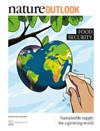
Twenty-first century robotics and sensing technologies have the potential to solve problems as old as farming itself. “I believe, by moving to a robotic agricultural system, we can make crop production significantly more efficient and more sustainable,” says Simon Blackmore, an engineer at Harper Adams University in Newport, UK. In greenhouses devoted to fruit and vegetable production, engineers are exploring automation as a way to reduce costs and boost quality (see ‘Ripe for the picking’). Devices to monitor vegetable growth, as well as robotic pickers, are currently being tested. For livestock farmers, sensing technologies can help to manage the health and welfare of their animals (‘Animal trackers’). And work is underway to improve monitoring and maintenance of soil quality (‘Silicon soil saviours’), and to eliminate pests and disease without resorting to indiscriminate use of agrichemicals (‘Eliminating enemies’).
Although some of these technologies are already available, most are at the research stage in labs and spin-off companies. “Big-machinery manufacturers are not putting their money into manufacturing agricultural robots because it goes against their current business models,” says Blackmore. Researchers such as Blackmore and Kantor are part of a growing body of scientists with plans to revolutionize agricultural practice. If they succeed, they'll change how we produce food forever. “We can use technology to double food production,” says Richard Green, agricultural engineer at Harper Adams.
Ripe for the picking
The Netherlands is famed for the efficiency of its fruit- and vegetable-growing greenhouses, but these operations rely on people to pick the produce. “Humans are still better than robots, but there is a lot of effort going into automatic harvesting,” says Eldert van Henten, an agricultural engineer at Wageningen University in the Netherlands, who is working on a sweet-pepper harvester. The challenge is to quickly and precisely identify the pepper and avoid cutting the main stem of the plant. The key lies in fast, precise software. “We are performing deep learning with the machine so it can interpret all the data from a colour camera fast,” says van Henten. “We even feed data from regular street scenes into the neural network to better train it.”
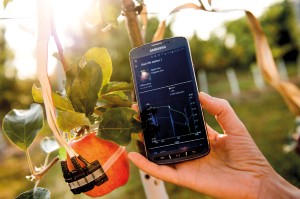
In the United Kingdom, Green has developed a strawberry harvester that he says can pick the fruit faster than humans. It relies on stereoscopic vision with RGB cameras to capture depth, but it is its powerful algorithms that allow it to pick a strawberry every two seconds. People can pick 15 to 20 a minute, Green estimates. “Our partners at the National Physical Laboratory worked on the problem for two years, but had a brainstorm one day and finally cracked it,” says Green, adding that the solution is too commercially sensitive to share. He thinks that supervised groups of robots can step into the shoes of strawberry pickers in around five years. Harper Adams University is considering setting up a spin-off company to commercialize the technology. The big hurdle to commercialization, however, is that food producers demand robots that can pick all kinds of vegetables, says van Henten. The variety of shapes, sizes and colours of tomatoes, for instance, makes picking them a tough challenge, although there is already a robot available to remove unwanted leaves from the plants.
Another key place to look for efficiencies is timing. Picking too early is wasteful because you miss out on growth, but picking too late slashes weeks off the storage time. Precision-farming engineer Manuela Zude-Sasse at the Leibniz Institute for Agricultural Engineering and Bioeconomy in Potsdam, Germany, is attaching sensors to apples to detect their size, and levels of the pigments chlorophyll and anthocyanin. The data are fed into an algorithm to calculate developmental stage, and, when the time is ripe for picking, growers are alerted by smartphone.
So far, Zude-Sasse has put sensors on pears, citrus fruits, peaches, bananas and apples (pictured). She is set to start field trials later this year in a commercial tomato greenhouse and an apple orchard. She is also developing a smartphone app for cherry growers. The app will use photographs of cherries taken by growers to calculate growth rate and a quality score.
Growing fresh fruit and vegetables is all about keeping the quality high while minimizing costs. “If you can schedule harvest to optimum fruit development, then you can reap an economic benefit and a quality one,” says Zude-Sasse.
Eliminating enemies
The Food and Agriculture Organization of the United Nations estimates that 20–40% of global crop yields are lost each year to pests and diseases, despite the application of around two-million tonnes of pesticide. Intelligent devices, such as robots and drones, could allow farmers to slash agrichemical use by spotting crop enemies earlier to allow precise chemical application or pest removal, for example. “The market is demanding foods with less herbicide and pesticide, and with greater quality,” says Red Whittaker, a robotics engineer at Carnegie Mellon who designed and patented an automated guidance system for tractors in 1997. “That challenge can be met by robots.”
“We predict drones, mounted with RGB or multispectral cameras, will take off every morning before the farmer gets up, and identify where within the field there is a pest or a problem,” says Green. As well as visible light, these cameras would be able to collect data from the invisible parts of the electromagnetic spectrum that could allow farmers to pinpoint a fungal disease, for example, before it becomes established. Scientists from Carnegie Mellon have begun to test the theory in sorghum (Sorghum bicolor), a staple in many parts of Africa and a potential biofuel crop in the United States.
Agribotix, an agriculture data-analysis company in Boulder, Colorado, supplies drones and software that use near-infrared images to map patches of unhealthy vegetation in large fields. Images can also reveal potential causes, such as pests or problems with irrigation. The company processes drone data from crop fields in more than 50 countries. It is now using machine learning to train its systems to differentiate between crops and weeds, and hopes to have this capability ready for the 2017 growing season. “We will be able to ping growers with an alert saying you have weeds growing in your field, here and here,” says crop scientist Jason Barton, an executive at Agribotix.
Modern technology that can autonomously eliminate pests and target agrichemicals better will reduce collateral damage to wildlife, lower resistance and cut costs. “We are working with a pesticide company keen to apply from the air using a drone,” says Green. Rather than spraying a whole field, the pesticide could be delivered to the right spot in the quantity needed, he says. The potential reductions in pesticide use are impressive. According to researchers at the University of Sydney's Australian Centre for Field Robotics, targeted spraying of vegetables used 0.1% of the volume of herbicide used in conventional blanket spraying. Their prototype robot is called RIPPA (Robot for Intelligent Perception and Precision Application) and shoots weeds with a directed micro-dose of liquid. Scientists at Harper Adams are going even further, testing a robot that does away with chemicals altogether by blasting weeds close to crops with a laser. “Cameras identify the growing point of the weed and our laser, which is no more than a concentrated heat source, heats it up to 95 °C, so the weed either dies or goes dormant,” says Blackmore.
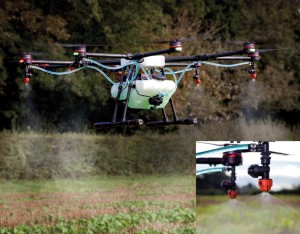
Animal trackers
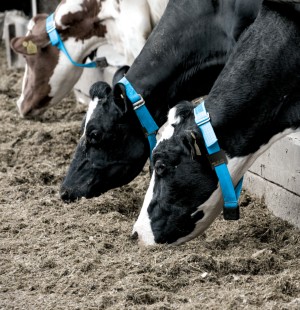
Smart collars — a bit like the wearable devices designed to track human health and fitness — have been used to monitor cows in Scotland since 2010. Developed by Glasgow start-up Silent Herdsman, the collar monitors fertility by tracking activity — cows move around more when they are fertile — and uses this to alert farmers to when a cow is ready to mate, sending a message to his or her laptop or smartphone. The collars (pictured), which are now being developed by Israeli dairy-farm-technology company Afimilk after they acquired Silent Herdsman last year, also detect early signs of illness by monitoring the average time each cow spends eating and ruminating, and warning the farmer via a smartphone if either declines.
“We are now looking at more subtle behavioural changes and how they might be related to animal health, such as lameness or acidosis,” says Richard Dewhurst, an animal nutritionist at Scotland's Rural College (SRUC) in Edinburgh, who is involved in research to expand the capabilities of the collar. Scientists are developing algorithms to interrogate data collected by the collars.
In a separate project, Dewhurst is analysing levels of exhaled ketones and sulfides in cow breath to reveal underfeeding and tissue breakdown or excess protein in their diet. “We have used selected-ionflow-tube mass spectrometry, but there are commercial sensors available,” says Dewhurst.
Cameras are also improving the detection of threats to cow health. The inflammatory condition mastitis — often the result of a bacterial infection — is one of the biggest costs to the dairy industry, causing declines in milk production or even death. Thermal-imaging cameras installed in cow sheds can spot hot, inflamed udders, allowing animals to be treated early.
Carol-Anne Duthie, an animal scientist at SRUC, is using 3D cameras to film cattle at water troughs to estimate the carcass grade (an assessment of the quality of a culled cow) and animal weight. These criteria determine the price producers are paid. Knowing the optimum time to sell would maximize profit and provide abattoirs with more-consistent animals. “This has knock on effects in terms of overall efficiency of the entire supply chain, reducing the animals which are out of specification reaching the abattoir,” Duthie explains.
And researchers in Belgium have developed a camera system to monitor broiler chickens in sheds. Three cameras continually track the movements of thousands of individual birds to spot problems quickly. “Analysing the behaviour of broilers can give an early warning for over 90% of problems,” says bioengineer Daniel Berckmans at the University of Leuven. The behaviour-monitoring system is being sold by Fancom, a livestock-husbandry firm in Panningen, the Netherlands. The Leuven researchers have also launched a cough monitor to flag respiratory problems in pigs, through a spin-off company called SoundTalks. This can give a warning 12 days earlier than farmers or vets would normally be able to detect a problem, says Berckmans. The microphone, which is positioned above animals in their pen, identifies sick individuals so that treatment can be targeted. “The idea was to reduce the use of antibiotics,” says Berckmans.
Berckmans is now working on downsizing a stress monitor designed for people so that it will attach to a cow's ear tag. “The more you stress an animal, the less energy is available from food for growth,” he says. The monitor takes 200 physiological measurements a second, alerting farmers through a smartphone when there is a problem.
Silicon soil saviours
The richest resource for arable farmers is soil. But large harvesters damage and compact soil, and overuse of agrichemicals such as nitrogen fertilizer are bad for both the environment and a farmer's bottom line. Robotics and autonomous machines could help.
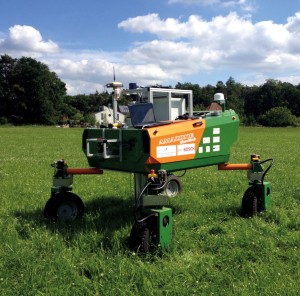
Data from drones are being used for smarter application of nitrogen fertilizer. “Healthy vegetation reflects more near-infrared light than unhealthy vegetation,” explains Barton. The ratio of red to near-infrared bands on a multispectral image can be used to estimate chlorophyll concentration and, therefore, to map biomass and see where interventions such as fertilization are needed after weather or pest damage, for example. When French agricultural technology company Airinov, which offers this type of drone survey, partnered with a French farming cooperative, they found that over a period of 3 years, in 627 fields of oilseed rape (Brassica napus), farmers used on average 34 kilograms less nitrogen fertilizer per hectare than they would without the survey data. This saved on average €107 (US$115) per hectare per year.
Bonirob (pictured) — a car-sized robot originally developed by a team of scientists including those at Osnabrück University of Applied Sciences in Germany — can measure other indicators of soil quality using various sensors and modules, including a moisture sensor and a penetrometer, which is used to assess soil compaction. According to Arno Ruckelshausen, an agricultural technologist at Osnabrück, Bonirob can take a sample of soil, liquidize it and analyse it to precisely map in real time characteristics such as pH and phosphorous levels. The University of Sydney's smaller RIPPA robot can also detect soil characteristics that affect crop production, by measuring soil conductivity.
Soil mapping opens the door to sowing different crop varieties in one field to better match shifting soil properties such as water availability. “You could differentially seed a field, for example, planting deep-rooting barley or wheat varieties in more sandy parts,” says Maurice Moloney, chief executive of the Global Institute for Food Security in Saskatoon, Canada. Growing multiple crops together could also lead to smarter use of agrichemicals. “Nature is strongly against monoculture, which is one reason we have to use massive amounts of herbicide and pesticides,” says van Henten. “It is about making the best use of resources.”
Mixed sowing would challenge an accepted pillar of agricultural wisdom: that economies of scale and the bulkiness of farm machinery mean vast fields of a single crop is the most-efficient way to farm, and the bigger the machine, the more-efficient the process. Some of the heaviest harvesters weigh 60 tonnes, cost more than a top-end sports car and leave a trail of soil compaction in their wake that can last for years.
But if there is no need for the farmer to drive the machine, then one large vehicle that covers as much area as possible is no longer needed. “As soon as you remove the human component, size is irrelevant,” says van Henten. Small, autonomous robots make mixed planting feasible and would not crush the soil.
In April, researchers at Harpers Adams began a proof-of-concept experiment with a hectare of barley. “We plan to grow and harvest the entire crop from start to finish with no humans entering the field,” says Green. The experiment will use existing machinery, such as tractors, that have been made autonomous, rather than new robots, but their goal is to use the software developed during this trial as the brains of purpose-built robots in the future. “Robots can facilitate a new way of doing agriculture,” says van Henten. Many of these disruptive technologies may not be ready for the prime time just yet, but the revolution is coming.
Related links
Related links
Related links in Nature Research
Agrobiodiversity: The living library
Outlook on agriculture and drought
Related external links
Rights and permissions
About this article
Cite this article
King, A. Technology: The Future of Agriculture. Nature 544, S21–S23 (2017). https://doi.org/10.1038/544S21a
Published:
Issue Date:
DOI: https://doi.org/10.1038/544S21a
This article is cited by
-
Enhancing Hill Farming Efficiency Using Unmanned Agricultural Vehicles: A Comprehensive Review
Transactions of the Indian National Academy of Engineering (2024)
-
How to make sense of 3D representations for plant phenotyping: a compendium of processing and analysis techniques
Plant Methods (2023)
-
Precise in-field molecular diagnostics of crop diseases by smartphone-based mutation-resolved pathogenic RNA analysis
Nature Communications (2023)
-
Nachhaltige Digitalisierung. Gesellschaftliche Transformation, autonome Materialität und der Fall des Digital Farming
Berliner Journal für Soziologie (2023)
